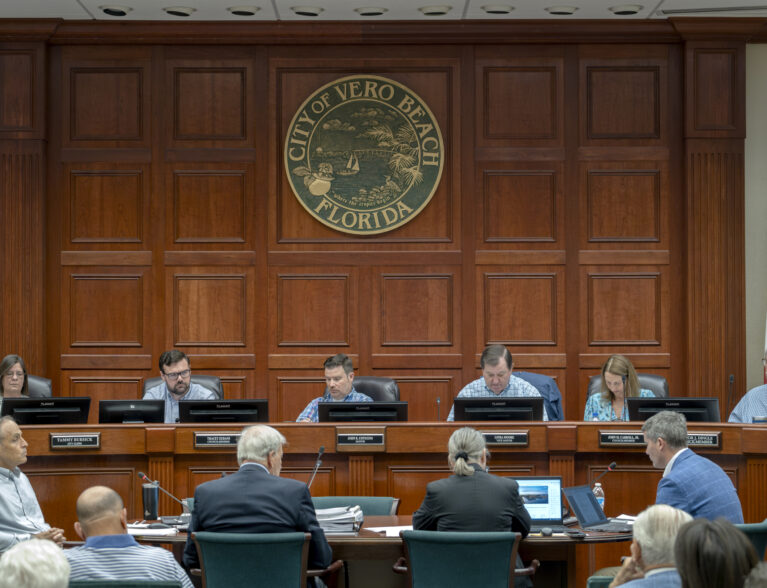
The creation of a waterfront destination on Vero Beach’s mainland moved a step closer to becoming a reality last week, when the city’s Three Corners Selection Committee made the proposal submitted by an Indiana-based development group the early frontrunner in its initial evaluation.
In fact, six of the committee’s seven members ranked the $504 million proposal submitted by Clearpath Services as their No. 1 choice among the four the city received in February.
“They clearly won the beauty contest,” committee member Jeb Bittner, chairman of the city’s Planning & Zoning Board, said of the Clearpath plan, which he called “very aspirational.”
Committee member Rob Bolton, the city’s Water and Sewer Administration director, also was impressed with the proposal submitted by the Bloomington, Indiana, partnership.
He said Clearpath “shot for the moon,” but tempered his enthusiasm with a warning that the plan might be too ambitious and need to be scaled back because of permitting issues relating to its proposed changes to the shoreline.
Bolton, Bittner and other committee members weren’t sure state and federal environmental regulators would allow Clearpath to construct the venue presented in its proposal, which includes an event center that would be built on a man-made island on the Indian River lagoon and a kayak/paddleboard canal that would require dredging to alter the shoreline.
“It’s not a red light,” Bittner said, “but a yellow light.”
Committee members also liked the way Clearpath connected the 17 acres it would develop – on the defunct power plant site, north of the 17th Street bridge – to the property to the south.
In addition, Bolton said, the Clearpath plan offers the most public access, most event space and more parking than the other proposals.
And City Planning and Development Director Jason Jeffries, who also serves on the committee, said Clearpath provided the “most complete plan” for the repurposing of the Big Blue power plant building.
Committee member Vicki Gould, who served as chairwoman of the Three Corners Steering Committee in the early stages of the process, said the Clearpath proposal also appears to create an experience closest to the vision presented by urban planning guru Andres Duany’s DPZ Co-Design firm, which the city hired to develop its concept plan for the site.
“This needs to be a special place,” Gould said. “There needs to be a wow factor.”
The Clearpath proposal, she added, “was exciting.”
It was so exciting, Bittner said, that it made the other proposals – including the committee’s No. 2 choice, submitted by the Vista Blue Vero Beach Resort & Spa group – appear lacking.
“This plan is a victim of being compared to Clearpath’s,” Bittner said, adding that the Vista Blue proposal “looks very subdivision-like” and “doesn’t make you want to walk through the campus.”
The committee’s biggest criticisms of the Vista Blue proposal were that it was too heavy on retail, too lacking in dining components, too little parking and too small a marina. It also had too much of a private-club, membership-necessary feel.
“It’s all about a hotel, with a little bit of dining,” Bolton said, adding that there’s no event center, no cultural or educational features and few recreational amenities open to the public.
“It doesn’t excite me in any way.”
Jeffries pointed out that the proposal doesn’t provide a plan for the repurposing of Big Blue.
Still, four of the committee’s seven members ranked it No. 2, and Bob Jones, chairman of the city’s Finance Commission, put Vista Blue atop his list.
The proposal from the Edgewater Group, based in Fort Lauderdale, was ranked No. 3, ahead of only the plan submitted by the Su-Da, Crec Capital, Madison Marquette partnership of Pompano Beach.
Committee members viewed the Edgewater proposal as being too marina-centric and lacking in other amenities, including a prominent waterfront village.
“This is a marina with a letter of interest from a hotel group,” Bittner said.
The proposal submitted by the Su-Da group was hindered by the developer’s late entry into the process, which resulted in a plan that was too bare-bones for the committee’s liking.
However, the Su-Da group still has time to add to its proposal and impress the committee.
All four developers will make individual presentations to the committee – two on May 13, two on May 17 – in closed-door sessions that are not open to the public.
Following those interviews, the committee will convene at 2:30 p.m. on May 17 for a public meeting to discuss and re-rank the proposals, then make its recommendation to the City Council.
The council will then interview the four groups – one at a time, behind closed doors – on May 21, then conduct a public meeting on May 28 to choose its Three Corners developer.
The Three Corners site contains 38 acres of waterfront property at the west end of the 17th Street bridge, at the intersection of Indian River Boulevard and 17th Street. There, the city plans to create a dining, retail, social and recreational hub.
The developer selected will build on only the current power plant property.



